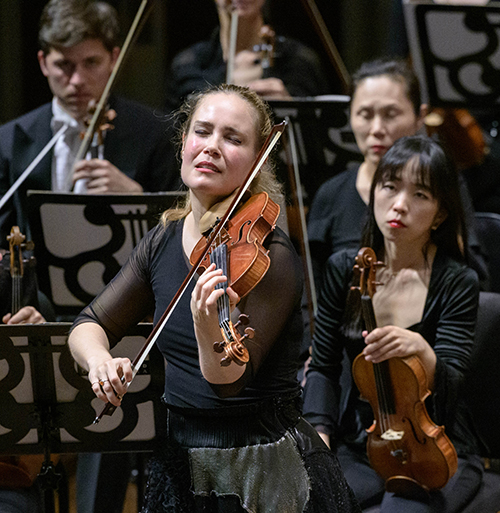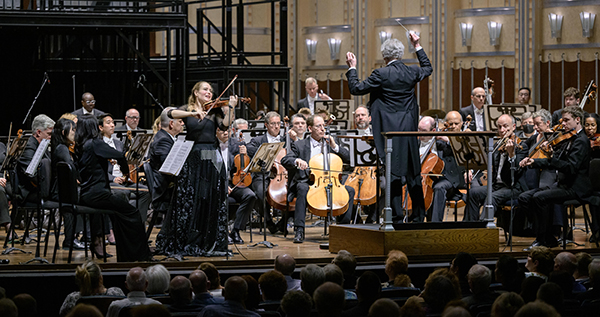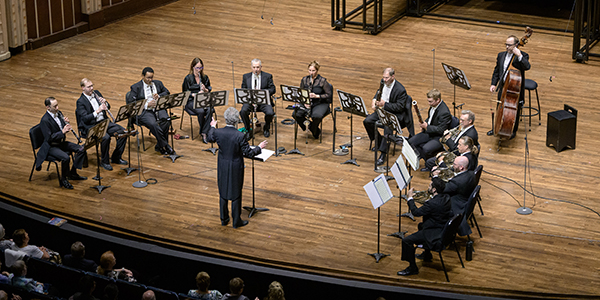By Daniel Hathaway | Cleveland Classical
This article was originally published on Cleveland.com

After a mammoth stage reset during intermission, music director Franz Welser-Möst and thirteen players filed onstage to serenade the large audience in Mandel Concert Hall at Severance Music Center with a glorious performance of Mozart’s Wind Serenade No. 10 (Gran Partita) that wonderfully shared the program with works by Wagner and Berg.
That was no small feat. The evening began with Richard Wagner’s Prelude and Liebestod from Tristan und Isolde and continued with Alban Berg’s Violin Concerto featuring Leila Josephowicz, works that made lasting impressions due to their sonic magnificence or the successful fusing of disparate musical elements.
Wagner’s opera shook up the world of 19th-century harmony with its first four bars. Cellos softly play a four-note motive that transitions into a dissonant but perfectly balanced “Tristan Chord” played by oboes, bassoon, and English horn that misbehaves by resolving into another dissonant chord.
Welser-Möst drew long, elastic phrases from the lush string sections supported by warm winds and horns that created a luxurious ebb and flow from the composer’s musical lines. Inner voices came through with astonishing clarity.
The excerpts, from the very beginning and ending of the opera, made an evocative opening for a program that — as the Mandel Opera and Humanities Festival program book states — reflects different eras and various expressions of power.

Josefowicz played with a luscious sound and both soloist and orchestra achieved stunning control over Berg’s material in the opening. Josefowicz clearly understands the place of every note in the concerto’s complicated 12-tone structure. She brought out the solo line when it was the primary voice, and took on an ensemble role when it was necessary to pass the primary lines from section to section and individual to individual.
In the second of two movements, Berg juxtaposes long accompanying lines with violent chords from the soloist, whose left-hand pizzicati in a masterful cadenza rang in the hall.
Then, a surprise. Out of a kind of primordial musical soup, the first four chords of J.S. Bach’s chorale Es ist genug came to the surface, elegantly played by the clarinets. For the rest of the movement the chorale seemed to be attempting to re-assemble itself.
Ultimately, Josefowicz’s solo line rises into the heavens, like the soul of Manon Gropius, the “Angel” to whom the concerto is dedicated.

Dinner music Mozart’s Serenades may be, but the Gran Partita demands that everyone play at the top of their game, and so they did in this unblemished performance of a huge work that captures every aspect of the composer’s musical personality.
Conducting without baton or podium, Welser-Möst led a relaxed, lively, but not overly-nuanced performance of the seven-movement work.
Special moments were numerous, but to name just a few, the clarinets and basset horns shone in the trio of the Menuet, the second menuetto, a country dance, was full of life, and the Romance showed Mozart to be a genius at opera as well as writing for winds (here, bassoonist John Clouser made easy work of some thorny continuo passages).
The final Molto allegro found Mozart still bursting with ideas, and the Cleveland winds with plenty of energy left to race to the finish in grand style. The audience loved it, giving the band of thirteen numerous callbacks.
Photos: Yevhen Gulenko
Daniel Hathaway is the founder and editor of the online journal ClevelandClassical.com. He teaches music journalism at Oberlin College and Conservatory of Music
Published on ClevelandClassical.com May 29, 2024
Click here for a printable copy of this article



